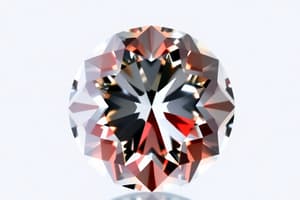Podcast
Questions and Answers
What are the three elements used to describe color in diamonds?
What are the three elements used to describe color in diamonds?
- Hue, tone, saturation (correct)
- Tone, saturation, clarity
- Hue, proportion, value
- Saturation, brightness, reflection
What is the Master-Eye Effect in diamond grading?
What is the Master-Eye Effect in diamond grading?
- A grading method that compares cut quality
- The process of determining the weight of a diamond
- Diamonds appearing colorless when viewed from below
- An optical illusion causing color perception to vary depending which side of the master stone the stone is on (correct)
Which color grading light is most widely accepted for evaluating diamonds?
Which color grading light is most widely accepted for evaluating diamonds?
- Direct sunlight
- Incandescent light
- Balanced, daylight-equivalent fluorescent light (correct)
- Colored LED light
What is saturation in the context of diamond color grading?
What is saturation in the context of diamond color grading?
Why is it important for masterstones and the diamond to be clean during color grading?
Why is it important for masterstones and the diamond to be clean during color grading?
What generally causes the biggest price difference among diamond color grades?
What generally causes the biggest price difference among diamond color grades?
What is the role of masterstones in the GIA diamond color grading system?
What is the role of masterstones in the GIA diamond color grading system?
What happens to cool and warm hues when saturation decreases?
What happens to cool and warm hues when saturation decreases?
What is the primary goal of colored diamond color grading?
What is the primary goal of colored diamond color grading?
How can proportion variations and size influence a diamond's color appearance?
How can proportion variations and size influence a diamond's color appearance?
What can influence the color of colored diamonds, making it so they’re graded face-up?
What can influence the color of colored diamonds, making it so they’re graded face-up?
What color differences can equal large value differences?
What color differences can equal large value differences?
What grading system is the universal standard in the jewelry industry?
What grading system is the universal standard in the jewelry industry?
Many colors that are called grays are in fact ...?
Many colors that are called grays are in fact ...?
You want the color grading environment to .....?
You want the color grading environment to .....?
The set of Masterstones should be matched to...?
The set of Masterstones should be matched to...?
The results can be fairly accurate when you ......
The results can be fairly accurate when you ......
Each letter on a masterset scale represents a narrow range of color, and each masterstone ........
Each letter on a masterset scale represents a narrow range of color, and each masterstone ........
The first impression of an object’s basic color is ....?
The first impression of an object’s basic color is ....?
The basic face-up color of a colored diamond is ....?
The basic face-up color of a colored diamond is ....?
The degree of darkness or lightness of a color is ...?
The degree of darkness or lightness of a color is ...?
The GIA color grading system helps diamond professionals......
The GIA color grading system helps diamond professionals......
The combination of tone and saturation is ...?
The combination of tone and saturation is ...?
Flashcards
Diamond Color Grading
Diamond Color Grading
A standardized system (GIA) used to determine a diamond's color.
Masterstones
Masterstones
Diamonds used as color comparison standards in GIA grading.
Hue
Hue
The basic color of an object.
Saturation
Saturation
Signup and view all the flashcards
Tone
Tone
Signup and view all the flashcards
Depth of Color
Depth of Color
Signup and view all the flashcards
Characteristic Color
Characteristic Color
Signup and view all the flashcards
GIA Color Grading System
GIA Color Grading System
Signup and view all the flashcards
Master-Eye Effect
Master-Eye Effect
Signup and view all the flashcards
Color Grading Environment
Color Grading Environment
Signup and view all the flashcards
Study Notes
Diamond Color Grading
- Characteristic Color: The basic visible color of a diamond.
- Depth of Color: The combination of tone and saturation of a diamond.
- Hue: The initial impression of diamond color.
- Master-Eye Effect: The optical illusion causing diamonds to appear lighter or darker compared to masterstones.
- Masterstones: A set of color-comparison diamonds that define GIA diamond color grades (D-to-Z).
- Saturation: The intensity of a diamond's color.
- Tone: The darkness or lightness of a diamond's color.
Key Concepts
- Slight color differences can significantly affect value.
- Color is described by hue, tone, and saturation.
- Low saturation colors appear grayish or brownish.
- GIA color grading is the industry standard.
- Each letter grade (e.g., D, E) represents a narrow color range with the least amount of color in each step.
- The biggest price difference is between D and E grades.
- Color grading should occur in a controlled environment with balanced or daylight-equivalent lighting.
- Matching masterstones to specific grading requirements and maintaining clean conditions for the diamonds and masterstones are crucial for accurate results.
- Cut, size, and clarity can also impact perceived color.
- The goal is repeatable and consistent color grading.
Studying That Suits You
Use AI to generate personalized quizzes and flashcards to suit your learning preferences.




